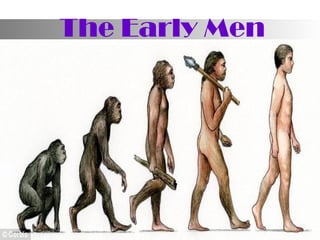
The early men 3
- 2. Definitions of Words 1. Anthropology - The study of human races, origins, societies, and cultures. 2. Glaciers - A very large area of ice that moves slowly down a slope or valley or over a wide area of land. 3. Archeology - A science that deals with past human life and activities by studying the bones, tools, etc, of ancient people. .
- 3. 4. Culture - A particular society that has its own bliefs , ways of life, art, etc. 5. Civilization - The condition that exists when peope have developedeffective ways of organizing a society and care aboutart, science, etc. 6. Ice age - A time in the distant past when a largeof the world was covered with ice.
- 4. The oldest known australopithecine skeleton was discovered in afar, Ethiopia by Donald Johnson, Tim White, and Tom Gray. The skeleton was that of a female and was named Lucy. She was probably 3.5 feet tall and may have lived about 4 million years ago.
- 5. LUCY
- 6. She is one of the most complete skeletons of an early ancestor of humans ever found. She walked upright, and anthropologist estimate hat she was about twenty years old when she died.
- 7. The Appearance of Early Humans Both humans and these pre - human creatures are called Homonids. which mean "two - legged primates". Anthropologist called the early pre - humans as Australopithecines. which means "southern ape".
- 8. Scientist divided Homo into 3 species 1. Homo habilis - or " man of skill ". lived during the firt quarter of the paleolithic period. They lived in Africa from about 2.5 million to 1.5 million years ago.
- 9. Homo habilis
- 10. 2. Homo erectus - or " person who walks upright ". Few researches split this into two species: a. Homo ergaster b. Homo erectus This type of homo first appeared in africa and lived from 1.8 million to about 30, 000 years ago.
- 11. Homo erectus
- 12. Homo erectus were food gatherers. Women gathered fruits, nuts, and seeds while Men looked for meat. By about 50, 000 years ago. Males had become hunters, using spears to kill deer, pigs, and rabbits.
- 13. These early humans also had learned how to make fire. They also make cloths for their own. They simply wrapped themselves in animal skins.
- 14. 3. Homo sapiens or " person who thinks ". First homo sapiens probably were the Neanderthals. They were named the Neanderthals by the anthropologists after the Neander Valley in Germany. Their remains first discovered in the 1850 CE.
- 15. Evidence shows that Neanderthal people may have originated in Africa and began spreading into Europe and Asia. about 100, 000 years ago. They stood about 5.5 feet tall. Their brains are slightly larger than those of modern human beings, and they had thick bones.
- 16. Neanderthal
- 17. Neanderthals were nomadic hunter gatherers who used fire for warmth and for cooking their food. They were advanced culturally. They cared for the sick and may have been the first to practice medicine. They believed in life after death.
- 18. Cro-magnons are prehistoric people who lived in Europe from about 40, 000 to 10, 000 years ago. Cro-magnons are scientifcally classified as Homo sapiens just as are people today. First modern humans to inhabit Europe.
- 19. Cro-magnons are named after the Cro-magnon rock shelter in Les Eyzies, southwestern France. Remains were first discovered in 1868. like other modern humans, cro-magnons had a high forehead, small brow ridges and a well defined chin.
- 20. Cro-magnons people first appeared in Europe about 40, 000 years ago, probably from the east and with an ultimate origin in Africa. Like the neanderthals, the cro- magnons were hunters and gatherers who lived off the bounty of nature.
- 21. Cro-magnons lived inside cave intrances while others built huts in forested areas. Cro-magnons were known for their creativity. Paintings found at Lascaux, France, as well as in other caves in Spain and Africa, are evidences of their artistry.
- 22. In the Philippines, the first known man was found in Cagayan Valley (750, 000-5,000 BCE). Scientists referred to him as the Cagayan Man or Homo erectus philippinensis.
- 23. Archeologists believe that the Cagayan Manor Homo Erectus philippinensis lived about 500, 000 years ago in Cagayan, but their skeletal remains have not been found yet. Archeological excavations, one in the 1970s revealed stone tools lying beside the fossils of large animals such as elephants, stegodons, rhinoceros, crocodiles, and giant turtles.
- 24. They use these kinds of tools for them to hunt those animals. Based on the stone tools and animal remains discovered, the Cagayan Man is believed to have survived through hunting and Plant gathering.
